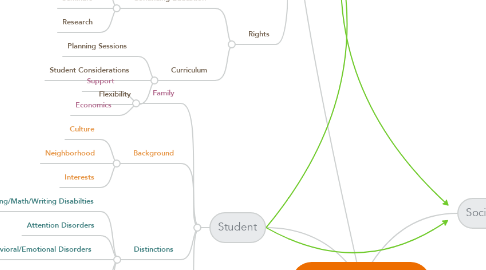
1. Teacher
1.1. Responsibilities
1.1.1. Student Centered Assessment
1.1.1.1. Formal
1.1.1.2. Informal
1.1.2. Classroom Environment
1.1.2.1. Inclusionary Classroom
1.1.2.2. UDL
1.2. Teaching Approach
1.2.1. Montessori
1.2.2. Waldorf
1.2.3. Reggio Emilia
1.2.4. Connectivism
1.3. Philosophies
1.3.1. Behaviorism
1.3.2. Cognitivism
1.3.3. Humanism
1.3.4. Constructivism
1.3.5. Transformative
1.3.6. Personal Background/Education
1.4. Rights
1.4.1. Continuing Education
1.4.1.1. Training
1.4.1.2. Seminars
1.4.1.3. Research
1.4.2. Curriculum
1.4.2.1. Planning Sessions
1.4.2.2. Student Considerations
1.4.2.3. Flexibility
2. Student
2.1. Family
2.1.1. Support
2.1.2. Economics
2.2. Background
2.2.1. Culture
2.2.2. Neighborhood
2.2.3. Interests
2.3. Distinctions
2.3.1. Reading/Math/Writing Disabilties
2.3.2. Attention Disorders
2.3.3. Behavioral/Emotional Disorders
2.3.4. Gifted
2.3.5. Physical Disabilities
2.4. Age
2.4.1. Cognitive Development
2.4.2. Pubertal Development
2.4.3. Emotional/Social Intelligence
3. Society
3.1. Technology
3.1.1. Rapid Information
3.1.2. Digital Environment
3.1.3. Code of Ethics
3.2. Legislation
3.2.1. NCLB
3.2.2. Race to the Top
3.2.3. Common Core
3.2.4. Standardized Testing
3.3. School Culture
3.3.1. Achievement Based
3.3.2. STEM Driven
3.3.3. Global Competitiveness
3.3.4. Data and Assessment Based
3.3.5. Charter/Magnet/Home School Movement

